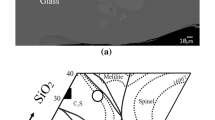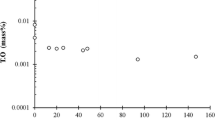Abstract
Pilot trails were carried out to study the formation mechanism of CaO-SiO2-Al2O3-(MgO) inclusions in tire cord steel. 48 samples were taken from 8 heats of liquid steel during secondary refining, which were subsequently examined by an automatic scanning electron microscope with energy dispersive spectrometer (SEM–EDS). Characteristics of thousands of oxide inclusions at different refining stages were obtained, including their compositions, sizes, morphologies, etc. Based on the obtained information of inclusions, details during formation of CaO-SiO2-Al2O3-(MgO) inclusions were revealed and a new mechanism was proposed, including their origin, formation, and evolution during the refining process. It was found that CaO-SiO2-Al2O3-(MgO) inclusions were initially originated from the CaO-SiO2-MnO-(MgO) inclusions, which were formed during BOF tapping by the coalescence between MnO-SiO2 deoxidation products and the emulsified slag particles because of violent flow of steel. This can be well confirmed by the evaluation of the formation thermodynamics of CaO-SiO2-MnO-(MgO) inclusions, which was proved very difficult to be produced by intrinsic reactions inside liquid steel. Because of chemical reactions between CaO-SiO2-MnO-(MgO) inclusions and molten steel, they were mainly changed into CaO-SiO2-MnO-Al2O3-(MgO) and partially into CaO-SiO2-Al2O3-(MgO), which may be detrimental to the cold drawing ability of coils. Based on this finding, improvements were made in industrial production during BOF tapping and secondary refining. The results indicated that such (CaO-SiO2)-based inclusions existed in conventional process were effectively decreased after the improvements.














Similar content being viewed by others
References
L. Peeters: Wire J. Int., 1980, vol. 13, pp. 96–99.
E. G. Demeye: Wire J. Int., 1981, vol. 14, pp. 72–77.
M. Barous and G. Mangel: Wire J. Int., 1984, vol. 17, pp. 66–71.
C. Gatellier, H. Gaye, J. Lehman, J. Bellot, and M. Moncel: Rev. Metall. Cah. Inf. Tec., 1992, vol. 89, pp. 361–69.
G. Bernard, P. V. Ribound and G. Urbain: Rev. Metall. Cah. Inf. Tec., 1981, vol. 78, pp. 421–34.
K. Iemura, H. Ichihashi, A. Kawami, and M. Mizutani: Proc. of the 3th Int. Conf. on Clean Steel., Brookfield. 1986, pp. 160–67.
S. Maede, T. Soejima, T. Saito, H. Matsumoto, H. Fujimoto, and T. Mimura: 72nd Steelmaking Conf. Proc., Chicago. 1989, pp. 379–85.
K. Karihara: Kobelco Technol. Rev., 2011, vol. 30, pp. 62-65.
Y. Shinsho, T. Nozaki, K. Sorimachi, E. Yamanaka, K. Suzuki, and K. Nakanishi: Wire J. Int., 1988, vol. 21, pp. 145–53.
H. Ohta and H. Sutio: Metall. Mater. Trans. B, 1996, vol. 27, pp. 263–70.
H. Suito and R. Inoue: ISIJ Int., 1996, vol. 36, pp. 528–36.
G. M. Fauling: Iron Steelmaker, 1999, vol. 26, pp. 29–36.
D. H. Woo, Y. B. Kang, and H. G. Lee: Metall. Mater. Trans. B, 2002, vol. 33B, pp. 915–20.
Y. B. Kang and H. G. Lee: ISIJ Int., 2004, vol. 44, pp. 1006–15.
S. H. Chen, M Jiang, X. F. He, and X. H. Wang: Int. J. Miner. Metall. Mater., 2012, vol. 19, pp. 490–98.
J.D. Seo, Y.T. Kim, and D.H. Kim: 5th Int. Congress on the Sci. and Technol. of Steelmaking, Dresden, German. 2012. pp. 1250–54.
J. S. Park and J. H. Park: Metall. Mater. Trans. B, 2014, vol. 45, pp. 953-60.
C.B. Guo, H.T. Ling, L.F. Zhang, C. Liu, G.S. Wang, and Y.B. GAO: 6th Int. Congress Sci. Technol. Steelmaking, Beijing. 2015. pp. 817–20.
A. Ueno, K. Kimura, A. Kawami, and M. Mizutani: 70th Steelmaking Conf. Proc., 1987. pp. 389–95.
E. Stampa and M. Cipparrone: Wire J. Int., 1987, vol. 20, pp. 44–55.
X. H. Wang, X. G. Li, F. X. Huan, H. B. Li, and J. Yang: Steel Res. Int., 2014, vol. 85, pp. 155–63.
A.W. Cramb and M. Byrne: 67th Steelmaking conf. proc., Chicago. 1984, pp. 5–13.
M. Byrne, A. W. Cramb, and T. W. Fenicle: Trans. ISS, 1989, vol. 10, pp. 51-60.
Acknowledgments
Sincere gratitude and appreciation should be expressed by the authors to Xingtai Iron and Steel Corp., Ltd. for supporting of the research and great help during industrial samplings.
Author information
Authors and Affiliations
Corresponding author
Additional information
Manuscript submitted September 21, 2015.
Rights and permissions
About this article
Cite this article
Wang, K., Jiang, M., Wang, X. et al. Formation Mechanism of CaO-SiO2-Al2O3-(MgO) Inclusions in Si-Mn-Killed Steel with Limited Aluminum Content During the Low Basicity Slag Refining. Metall Mater Trans B 47, 282–290 (2016). https://doi.org/10.1007/s11663-015-0502-z
Published:
Issue Date:
DOI: https://doi.org/10.1007/s11663-015-0502-z




